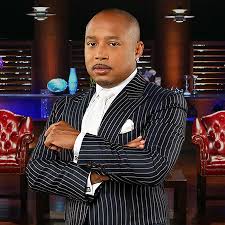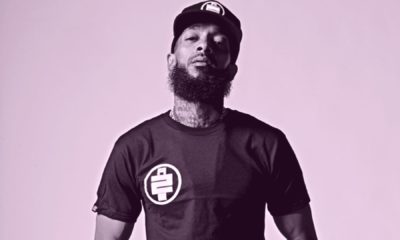Entrepreneurs
Why Daymond John Is So Successful
Daymond John is an Entrepreneuer, Investor, TV Personality, Author and Motivational Speaker from the United States.
He is most famous for being the founder and CEO of FUBU and more recently appearing on the reality TV Series, Shark Tank.
Daymond John’s Early Years
 Daymond John grew up in Hollis, Queens, New York City. A place that was rapidly becoming the central hub of a new genre of music known as Hip Hop, compounded by acts like Salt N Peppa and RUN DMC.
Daymond John grew up in Hollis, Queens, New York City. A place that was rapidly becoming the central hub of a new genre of music known as Hip Hop, compounded by acts like Salt N Peppa and RUN DMC.
It was this environment that would end up providing the inspiration for his clothing line that would carve its own lane in the fashion world.
“If you don’t educate yourself, you’ll never get out of the starting block because you’ll spend all your money making foolish decisions.” – Daymond John
 Daymond’s first venture into the apparel marketplace came when he wanted a tie-top hat that he had seen in a popular music video but couldn’t find for a reasonable price. He took the sewing skills that he learned from his mother and the entrepreneurial spirit that he learned from a co-op program in high school and he began making the hats for himself and his peers.
Daymond’s first venture into the apparel marketplace came when he wanted a tie-top hat that he had seen in a popular music video but couldn’t find for a reasonable price. He took the sewing skills that he learned from his mother and the entrepreneurial spirit that he learned from a co-op program in high school and he began making the hats for himself and his peers.
John quickly realized that this could be very lucrative and he made a large order of the tie-top hats and he went around Queens selling them and made over $800 in a few short hours.
The Birth of FUBU
 John took this early success and recruited some of his peers from the neighbourhood and FUBU was born.
John took this early success and recruited some of his peers from the neighbourhood and FUBU was born.
Daymond and his team created a distinctive logo and began sewing it onto all different types of apparel, from hockey jerseys, to sweatshirts to T-Shirts.
Daymond John’s estimated net worth is $250 Million.
The brand gained an incredible level of credibility and sky-rocketed when John convinced Queens native and Hip Hop Superstar, LL Cool J, to wear FUBU for a promotional campaign. This resulted in the whole hip-hop community getting behind the brand which meant that John needed more capital to keep up with demand.
Daymond John mortgaged the home that he owned with his mother for $100,000 and turned it into a makeshift factory/office.
The Growth of an Iconic Brand
 John’s creative vision and marketplace knowledge allowed him to push on and create one of the most iconic fashion brands of modern times. FUBU, standing for “For Us By Us” was a representation of a lifestyle that wasn’t in the fashion market at that time.
John’s creative vision and marketplace knowledge allowed him to push on and create one of the most iconic fashion brands of modern times. FUBU, standing for “For Us By Us” was a representation of a lifestyle that wasn’t in the fashion market at that time.
FUBU gained nationwide exposure when John and his partners went to the industry trade show, Magic, in Las Vegas. They couldn’t afford a booth at the event but they showed potential buyer’s their unique, colourful clothes in a hotel room.
“Mentors, by far, are the most important aspects of businesses” – Daymond John
The company arrived back from Vegas with more than $300,000 worth of orders and soon had a contract with the New York City based department store chain, Macy’s. John and FUBU then moved on to expand into jeans, outerwear and more.
A distribution deal with Samsung Electronics allowed FUBU‘s designs to be produced and delivered on a huge scale. The brand was now in mainstream markets and recording annual sales of $350 Million. John had built a clothing company from scratch that was rivalling brands like Tommy Hilfiger.
Daymond John the TV Personality
 In 2009, John joined the cast of the ABC business show, Shark Tank. As one of the ‘Sharks’, John and four other entrepreneurs consider the business pitches of members of the public looking to take their idea/company to the next level.
In 2009, John joined the cast of the ABC business show, Shark Tank. As one of the ‘Sharks’, John and four other entrepreneurs consider the business pitches of members of the public looking to take their idea/company to the next level.
Daymond went on to invest his own money to become partners with several of the budding entrepreneurs to help them make their dreams a reality.
Daymond John’s Books
 John released his first book, Display of Power: How FUBU Changed A World Of Fashion, Branding And Lifestyle to tell the story of his incredible journey and to provide inspiration and education for people looking to succeed in business and in life.
John released his first book, Display of Power: How FUBU Changed A World Of Fashion, Branding And Lifestyle to tell the story of his incredible journey and to provide inspiration and education for people looking to succeed in business and in life.
Daymond John followed this with his second book: The Brand Within: How We Brand Ourselves, From Birth To The Boardroom which explores the relationships that companies aim to create with the public by attaching celebrities to their brands to increase the consumers buying impulse.
John uses his vast knowledge and his association with top marketers to argue that branding relationships have made their way into every aspect of our lives.
Conclusion
Daymond John is an amazing example of how a belief in an idea, combined with a persistent drive to make things happen can make you successful.
Daymond has a wonderful ability to see things ahead of the trend and take action on his positive visions.
Daymond John on his Worst Mistakes
https://www.youtube.com/watch?v=2ST6cnXgQhM
Change Your Mindset
The Silent Skill That Makes People Respect You Instantly
What truly earns respect and why most people go about it the wrong way

Everybody craves respect but not everyone earns it. Some people believe that a title, years of experience, or a position of authority automatically entitles them to respect. (more…)
Entrepreneurs
The Essential Skills Every Entrepreneur Needs In 2026
Success in the digital age isn’t about luck. It’s about mastering the skills that separate dreamers from doers.

When I was 22 years old, I started my first side hustle as a ghostwriter. (more…)
Business
The Hidden Money Pit in Your Operations (and How to Use It)
See how smart asset management software is quietly saving businesses thousands in wasted time, stock, and maintenance.

Trimming unnecessary expenses and minimizing resources is a general practice in running a business effectively. Asset management software can help you achieve those goals. (more…)
Business
Thinking of Buying A Business? These 6 Sectors Quietly Produce the Best Deals
Before you buy your next venture, check out the sectors where successful businesses are changing hands every day.

All entrepreneurs have a desire to be the masters behind a successful venture. Buying an established business is a great choice for many. This provides instant access to an established market with existing infrastructure and clients. (more…)
-

 Success Advice4 weeks ago
Success Advice4 weeks agoInside the TikTok Resume Hack That’s Fooling Recruiters (For Now)
-

 Change Your Mindset4 weeks ago
Change Your Mindset4 weeks agoThe One Leadership Habit That Separates the Great From the Forgettable
-

 Personal Development3 weeks ago
Personal Development3 weeks agoThis Silent Habit Might Be Sabotaging Your Career
-

 Business3 weeks ago
Business3 weeks agoWhy Your E-Commerce Fulfilment Is Probably Broken (And How to Fix It)
-

 Shift Your Mindset2 weeks ago
Shift Your Mindset2 weeks ago11 E’s That Define Every Great Leader And Why Most People Miss Them
-

 Did You Know2 weeks ago
Did You Know2 weeks agoThe Success Patterns You Inherited (And Didn’t Notice)
-

 Business2 weeks ago
Business2 weeks agoThe Hidden Money Pit in Your Operations (and How to Use It)
-

 Entrepreneurs7 days ago
Entrepreneurs7 days agoThe Essential Skills Every Entrepreneur Needs In 2026



























5 Comments